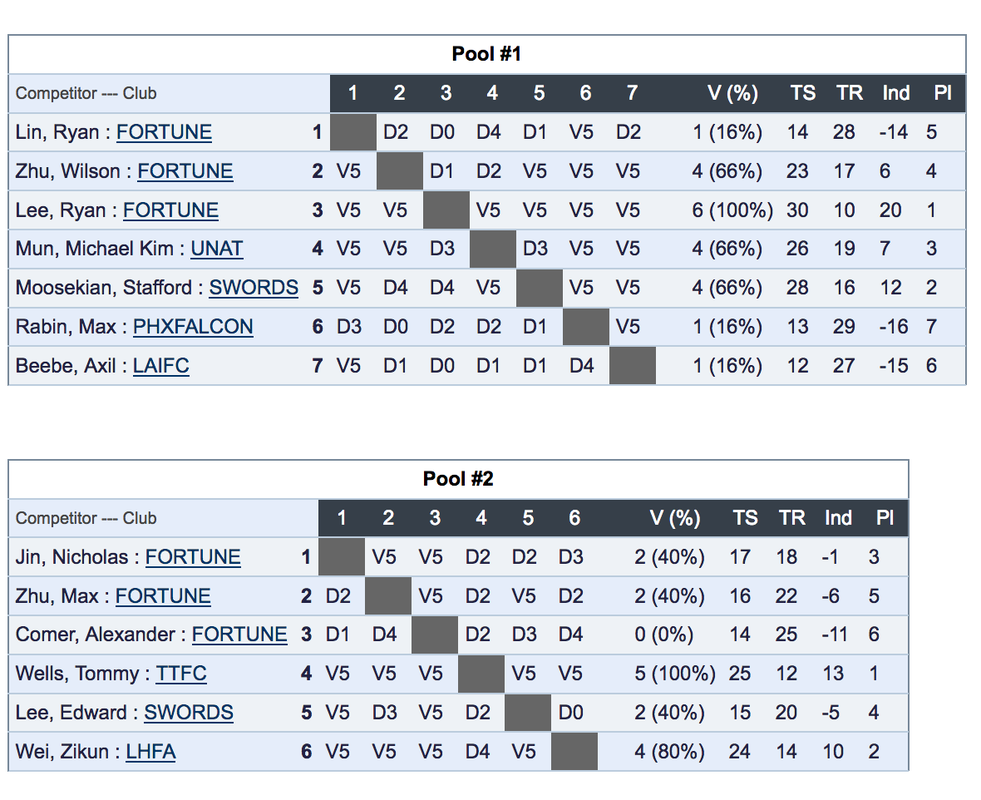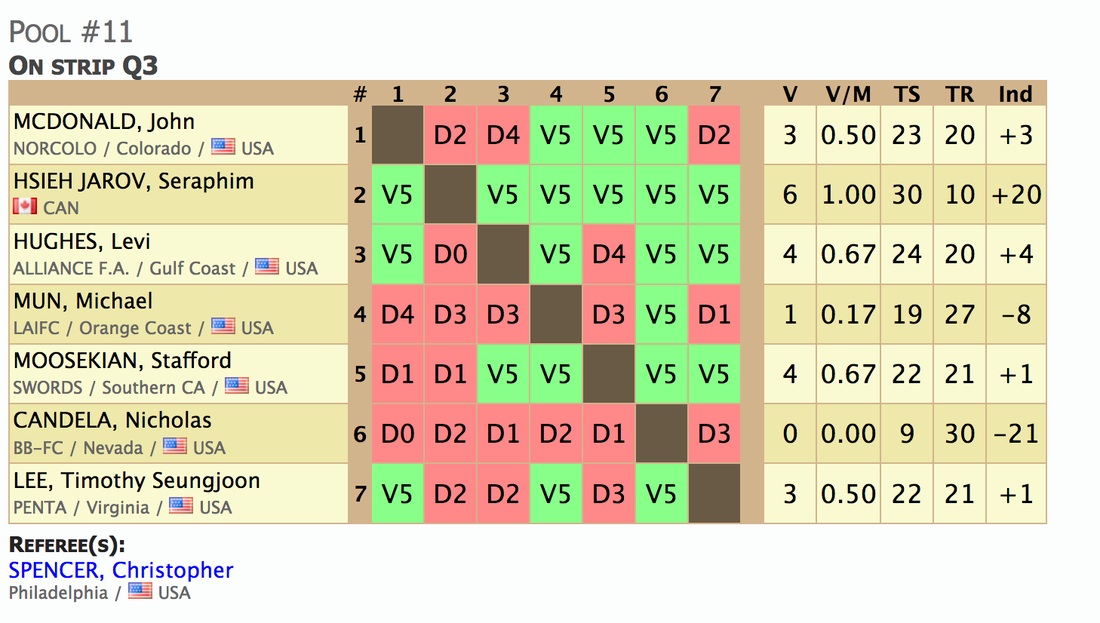|
How exactly does a tournament event work? An event in a fencing tournament consists of two parts, the first - Pools, and the second part, Direct Eliminations, which is based on the outcome of the pools. Time: One of the biggest questions that new fencing families have is how long will an event take? My experience? If there are over 30 fencers, plan to be at the event all day. If there are less than 30 fencers, plan for at least three hours. There can be all kinds of delays, some small, some huge. An example of a small delay, at a small tournament, a fencer who has signed up is caught in traffic and because he has called ahead and is making all efforts to arrive on time, the organizers agree to hold the close of registration a few more minutes. A large delay? Sometimes, at larger tournaments, if there are not enough referees or strips, pools can be flighted. This means the pools will be divided into two groups. The first group will begin at the original, announced time and the second group will either begin at a later specified time, or will simply be assigned to a strip and will begin when the first pool has concluded. This past 2018 Junior Olympics in Memphis, TN, Cadet Men’s Epee was flighted, so the first round of pools started at 8:00am, and the second one at 10:00am. If you are in the second pool, you have a two hour wait. If your fencer is a beginning fencer, chances are he or she will be nervous at the prospect of fencing in a tournament. Whether the tournament is large or small, if you can make the tournament the focus for the day, it can help your fencer feel more confident about fencing. This doesn’t mean focus on results or winning. This means try not to have other events competing for attention with a tournament, so your focus is not pulled away from supporting your child to worrying about whether or not you will be able to make the next event, etc. Another recommendation is to maybe plan a celebratory family dinner, or even go to dinner with other fencers after the event. Whether or not your fencer comes home with a medal, he or she will have new experiences to review, things to celebrate as well as learn from, and always a story to tell. Enjoy! Part One - Pools: Things to know before Pools begin-
How Pools Work Pools are made up of all of the fencers entered (and checked in) in the event, with the top seeded fencers each getting their own pools.
Pool Structure:
At the end of the pool bouts, each fencer is asked to review the score sheet and then sign his or her name. Referees can and occasionally do make mistakes. Make sure your fencer really looks at the sheet before signing. I keep track of all of Stafford’s pools in Notes on my phone and then show it to him to review before looking at the score sheet just to refresh his memory. The more your fencer competes, the more he or she will remember the bout scores. Your fencer should always shake hands with the referee after signing the pool sheet. Scoring out of pools:
Promotion to the next round: In Y10, Y12, and Y14 events, 100% of the fencers are promoted to the Direct Eliminations whether in local, regional, or national tournaments. This way, younger, less experienced fencers are able to fence more and gain experience in a tournament atmosphere. In Cadet, Junior, and Division national events, the bottom 20% are eliminated and do not move on to the direct eliminations. Here are pool results for a smaller, local tournament: 13 fencers – 2 pools, one of 7, one of 6 First out of Pool #1 – Ryan Lee, who won all of his pools, scored 30 touches, and received 10 touches. So his indicator is 20 (30 – 10). First out of Pool #2 - Tommy Wells, who won all of his pools, scoring 25 touches and receiving 12, so his indicator is 13. Remember, Tommy had a smaller pool so though he won them all, he would come in behind the other fencer in a larger pool who also won all of his or her pools. So, seeding out of pools - Lee #1 and Wells #2 Who came out third? Three boys had 4 victories, Wilson Zhu (ind. 6), Stafford Moosekian (ind. 12), and Zikun Wei (ind. 10). You would think from the indicator that Stafford would have come out third – but- he lost two bouts, whereas Zikun only lost one. Remember one pool was 7 and one 6. So, though they have the same number of victories, Stafford lost two, so Zikun took the third place out of pools. Make sense? Here is another example: in the much bigger tournament, the 2017 Summer Nationals Cadet Men’s Epee Event, using Stafford Moosekian as an example: Stafford won 4 bouts scored 22 touches, received 21 touches. By the way, V5 means he scored 5 touches. You can win the bout V1, meaning with only one touch scored, which would change your touches scored number but not the number of victories you have. Stafford’s indicator is 22-21, so +1. If he had received more touches than he had scored, the indicator would be a negative number (like Michael Mun or Nicholas Candela in this example). Once the seeding from pools is posted, fencers have a few minutes to verify their indicator and seeding before the next round, the Direct Eliminations, begins. Stafford came out of pools seeded at 60. You can see the two boys who placed ahead of Stafford had the same indicator, +1, but because they scored more touches, they placed ahead of him. Tristan Szapery, because he had 4 victories but his indicator, at 0, is the lowest of those who earned 4 victories, brings up the bottom of the group who had 4 victories. The boy right under him had a higher indicator, but he only won 3 of his bouts, so he will be seeded just below those who won 4.
Once pools are done, take a deep breath. Your fencer has some time to relax, anywhere from 20 minutes at smaller tournaments to much longer if pools are flighted and your fencer is in the first round of pools. He should get something light to eat. Fruit, a sandwich, etc. Be sure she hydrates, as well. Gatorade or Vitamin Water help replenish electrolytes. Also, many fencers like to change into a clean t-shirt for the next part of the tournament - the Direct Eliminations. After the seeding is posted for the Direct Eliminations, your fencer has a few minutes during which he or she should start to warm up, do some stretches, maybe even do a warm up bout. Next - Direct Eliminations!
3 Comments
Thomas Ferriere
2/25/2018 08:25:44 pm
Thanks a lot for this post. Very informative, I was still a bit confused about the pool.
Reply
Selena Chen
3/14/2018 03:58:53 pm
Very detailed and helpful information about the fencing tournament. I have learned something from it. Great job, keep on going!
Reply
Leave a Reply. |
Tournament Fencing Needs
Mandatory: Additional Helpful links: USA Fencing National Athlete Ranking - Men's Epee National Athlete Ranking - Women's Epee Regional Points Standings USA Fencing Athlete Handbook SoCal Divison AskFred AuthorKathryn Atwood - Swords Fencing Studio. We welcome any questions and comments, suggestions for topics, etc. Categories
All
Archives
March 2019
USA Fencing Rules Book
|
||||||
Photo from daniel0685



 RSS Feed
RSS Feed
